A Procedure to Transform Recycling Behavior for Source Separation of Household Waste
Abstract
:1. Introduction
Objectives
- How should the current sorting behavior be evaluated?
- How should the appropriate interventions to improve this behavior be identified?
- How should the effect of interventions be assessed?
2. Methods and Materials
2.1. Design of the Study
2.2. Description of the Pilot Area Used to Test the Procedure
2.3. Methods
2.3.1. Waste Composition Study (Pick Analysis)
2.3.2. Interview
Semi-Structured Interview
Structured Interview
2.3.3. Interventions in the Pilot Study
3. Results and Discussion
3.1. Pilot Area
3.1.1. First Pick Analysis—Evaluation of the Current Sorting Behavior
3.1.2. Interviews for Identifying Appropriate Interventions to Improve Sorting Behavior
Semi-Structured Interview
- The interviewees were willing to sort the waste.
- The interviewees had different motivations to sort the waste.
- Decreasing the distance to collection points for recyclables can be a relevant intervention.
- There was a lack of knowledge of how to sort the waste.
- Designing different types of information that is communicated at the appropriate time and place, via formal and informal channels, may also be a relevant intervention.
Structured Interview
3.1.3. Effect of Interventions
3.2. Recycling Behavior Transition (RBT) Procedure
- The combination of quantitative and qualitative methods provides reliable and useful results to implement the appropriate interventions.
- The RBT procedure can be applied in any source separation system in any location, independent of local circumstances. The procedure can be used to identify the relevant intervention in other cultures, socio-economic backgrounds, and other source separation schemes.
- The RBT procedure quantifies the effect of the interventions. Actors responsible for planning waste management may hesitate to apply interventions because they do not know how to identify them and how to measure their effect. This procedure can help them not only to improve their system, but also to control the quality of the system.
- The RBT procedure focuses on user involvement in waste management systems. When the intervention is identified from the needs of the users, there is a higher probability of success.
- The continued improvement of source separation systems results in the collection of recyclable materials in larger quantities and of better quality, and consequently help in the development of a circular economy and sustainable development.
- The RBT procedure requires careful design in both time and implementation, and one often needs to wait for a specific time period for implementing interventions so that the pick analyses that are performed before and after the interventions can be compared to each other. In addition, since the procedure requires a long time, the effectiveness of the interventions is reduced if many residents move into and out of the neighborhood during the time between successive pick analyses.
- Interviews with the inhabitants to identify proper interventions are good since it identifies interventions that are relevant to the inhabitants and also increases the involvement the inhabitants in the waste management system. However, these interviews may lead to improved sorting behavior (which is good in many perspectives) which means that the effect of the intervention is difficult to isolate.
- Pick analyses, which are an integral part of the RBT procedure, require large sample sizes to be statistically meaningful. This increases the cost of the procedure.
4. Conclusions and Outlook
Author Contributions
Conflicts of Interest
Abbreviations
| RBT | Recycling Behavior Transition |
References
- Swedish Waste Management. Swedish Waste Management 2015; Rapport U2015:25; Swedish Waste Management: Malmö, Sweden, 2015. (In Swedish) [Google Scholar]
- Rousta, K.; Dahlén, L. Source separation of household waste; technology and social aspects. In Resource Recovery to Approach Zero Municipal Waste; Taherzadeh, M.J., Richards, T., Eds.; CRC Press: Boca Raton, FL, USA, 2015; pp. 61–77. [Google Scholar]
- Guerin, D.; Crete, J.; Mercier, J. A multilevel analysis of the determinants of recycling behavior in the european countries. Soc. Sci. Res. 2001, 30, 195–218. [Google Scholar] [CrossRef]
- Jesson, J. Household waste recycling behavior: A market segmentation model. Soc. Mark. Q. 2009, 15, 25–38. [Google Scholar] [CrossRef]
- Martin, M.; Williams, I.D.; Clark, M. Social, cultural and structural influences on household waste recycling: A case study. Resour. Conserv. Recycl. 2006, 48, 357–395. [Google Scholar] [CrossRef]
- Meneses, G.D.; Palacio, A.B. Recycling behavior a multidimensional approach. Environ. Behav. 2005, 37, 837–860. [Google Scholar] [CrossRef]
- Oskamp, S.; Harrington, M.J.; Edwards, T.C.; Sherwood, D.L.; Okuda, S.M.; Swanson, D.C. Factors influencing household recycling behavior. Environ. Behav. 1991, 23, 494–519. [Google Scholar] [CrossRef]
- Tucker, P.; Speirs, D. Count me as doing my bit: An appraisal of the accuracy of waste attitude/behaviour surveys. CIWM Sci. Tech. Rev. 2003, 4, 2003. [Google Scholar]
- Dahlén, L.; Åberg, H.; Lagerkvist, A.; Berg, P.E.O. Inconsistent pathways of household waste. Waste Manag. 2009, 29, 1798–1806. [Google Scholar] [CrossRef] [PubMed]
- González-Torre, P.L.; Adenso-Díaz, B. Influence of distance on the motivation and frequency of household recycling. Waste Manag. 2005, 25, 15–23. [Google Scholar] [CrossRef] [PubMed]
- Porter, B.E.; Leeming, F.C.; Dwyer, W.O. Solid waste recovery a review of behavioral programs to increase recycling. Environ. Behav. 1995, 27, 122–152. [Google Scholar] [CrossRef]
- Refsgaard, K.; Magnussen, K. Household behaviour and attitudes with respect to recycling food waste—Experiences from focus groups. J. Environ. Manag. 2009, 90, 760–771. [Google Scholar] [CrossRef] [PubMed]
- Thøgersen, J. A model of recycling behaviour, with evidence from danish source separation programmes. Int. J. Res. Mark. 1994, 11, 145–163. [Google Scholar] [CrossRef]
- Barr, S. Household Waste in Social Perspective; Values, Attitudes, Situation and Behaviour; ASHGATE: Burlington, VT, USA, 2002. [Google Scholar]
- Pieters, R.; Verplanken, B. Changing our mind about behavior. In The Consumption of Time and the Timing of Consumption—Toward a New Behavioral and Socio-Economics; North-Holland: Amsterdam, The Netherlands, 1991. [Google Scholar]
- Tucker, P.; Smith, D. Simulating household waste management behaviour. J. Artif. Soc. Soc. Simul. 1999, 2, 31. [Google Scholar]
- Tucker, P. Understanding recycling behaviour. Pap. Technol. 2001, 42, 51–54. [Google Scholar]
- Wilson, D.C.; Rodic, L.; Scheinberg, A.; Velis, C.A.; Alabaster, G. Comparative analysis of solid waste management in 20 cities. Waste Manag. Res. 2012, 30, 237–254. [Google Scholar] [CrossRef] [PubMed]
- Stringer, E.T. Action Research; SAGE: Los Angeles, CA, USA, 2014. [Google Scholar]
- Dahlén, L.; Lagerkvist, A. Methods for household waste composition studies. Waste Manag. 2008, 28, 1100–1112. [Google Scholar] [CrossRef] [PubMed]
- Myers, M.D. Qualitative Research in Business and Management; Sage: Thousand Oaks, CA, USA, 2009. [Google Scholar]
- Kvale, S.; Brinkmann, S. Den Kvalitativa Forskningsintervjun; Studentlitteratur AB: Lund, Sweden, 2009. [Google Scholar]
- Rousta, K.; Ekström, K.M. Assessing incorrect household waste sorting in a medium-sized Swedish city. Sustainability 2013, 5, 4349–4361. [Google Scholar] [CrossRef]
- Swedish Statistisc. Socio-Economic Statistics; Swedish Statistisc: Stockholm, Sweden, 2012. [Google Scholar]
- Swedish Waste Management. Manual for Pick Analysis of Houshold Waste/Manual för Plockanalys av Hushållsavfall; RVF Utveckling 2005:19; Swedish Waste Management: Malmö, Sweden, 2005. (In Swedish) [Google Scholar]
- Swedish Waste Management. Manual for Pick Analysis of Houshold Waste/Manual för Plockanalys av Hushållsavfall; RVF Utveckling 2013:11; Swedish Waste Management: Malmö, Sweden, 2013. (In Swedish) [Google Scholar]
- Drever, E. Using Semi-Structured Interviews in Small-Scale Research. A Teacher’s Guide; ERIC: Glasgow, UK, 1995. [Google Scholar]
- Henriksson, G.; Åkesson, L.; Ewert, S. Uncertainty regarding waste handling in everyday life. Sustainability 2010, 2, 2799–2813. [Google Scholar] [CrossRef]
- Thøgersen, J. Facilitating recycling: Reverse—Distribution channel design for participation and support. Soc. Mark. Q. 1997, 4, 42–55. [Google Scholar] [CrossRef]
- Tashakkori, A.; Teddlie, C. Sage Handbook of Mixed Methods in Social & Behavioral Research; Sage: Thousand Oaks, CA, USA, 2010. [Google Scholar]
- Newenhouse, S.C.; Schmit, J.T. Qualitative methods add value to waste characterization studies. Waste Manag. Res. 2000, 18, 105–114. [Google Scholar] [CrossRef]
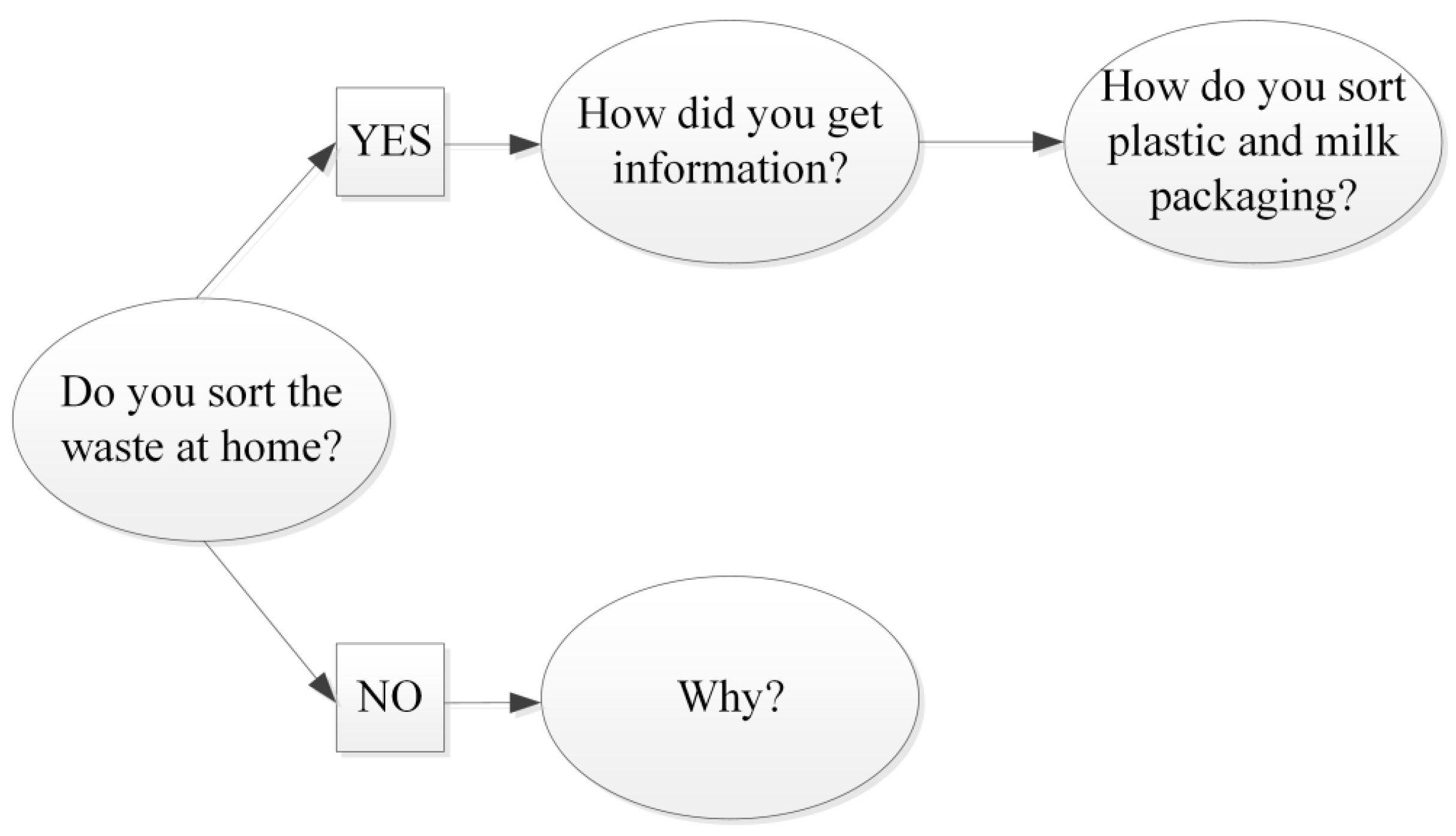
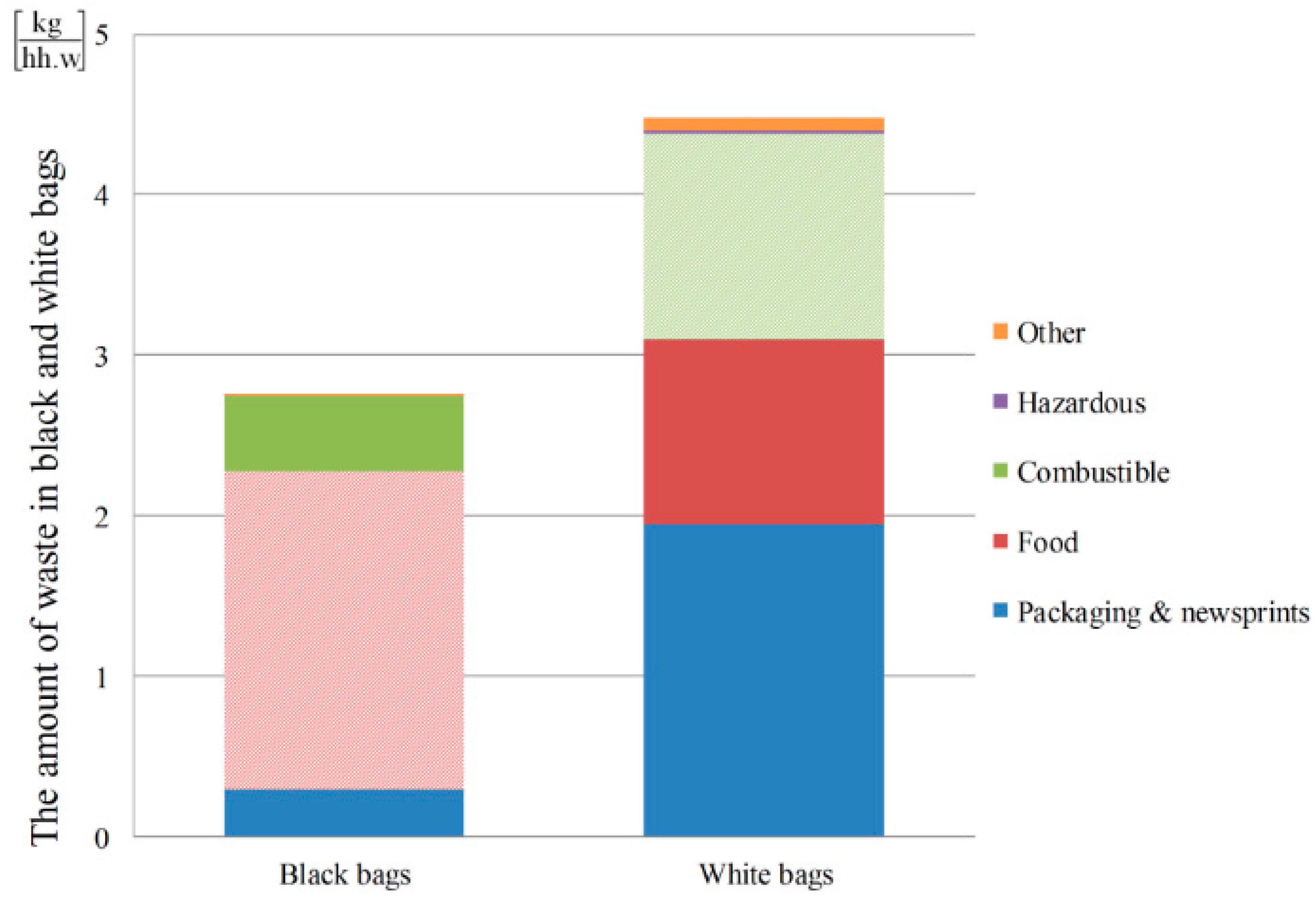

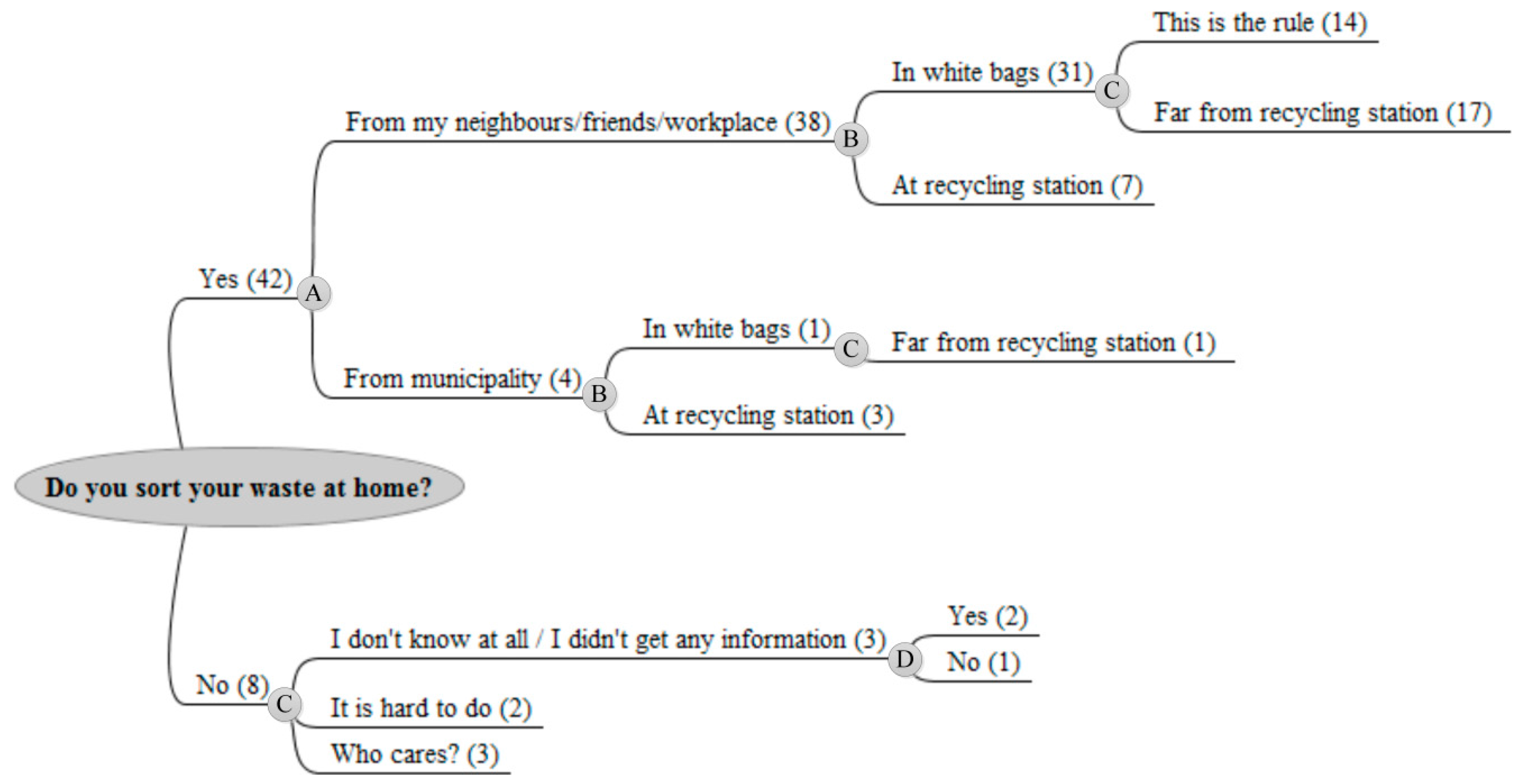


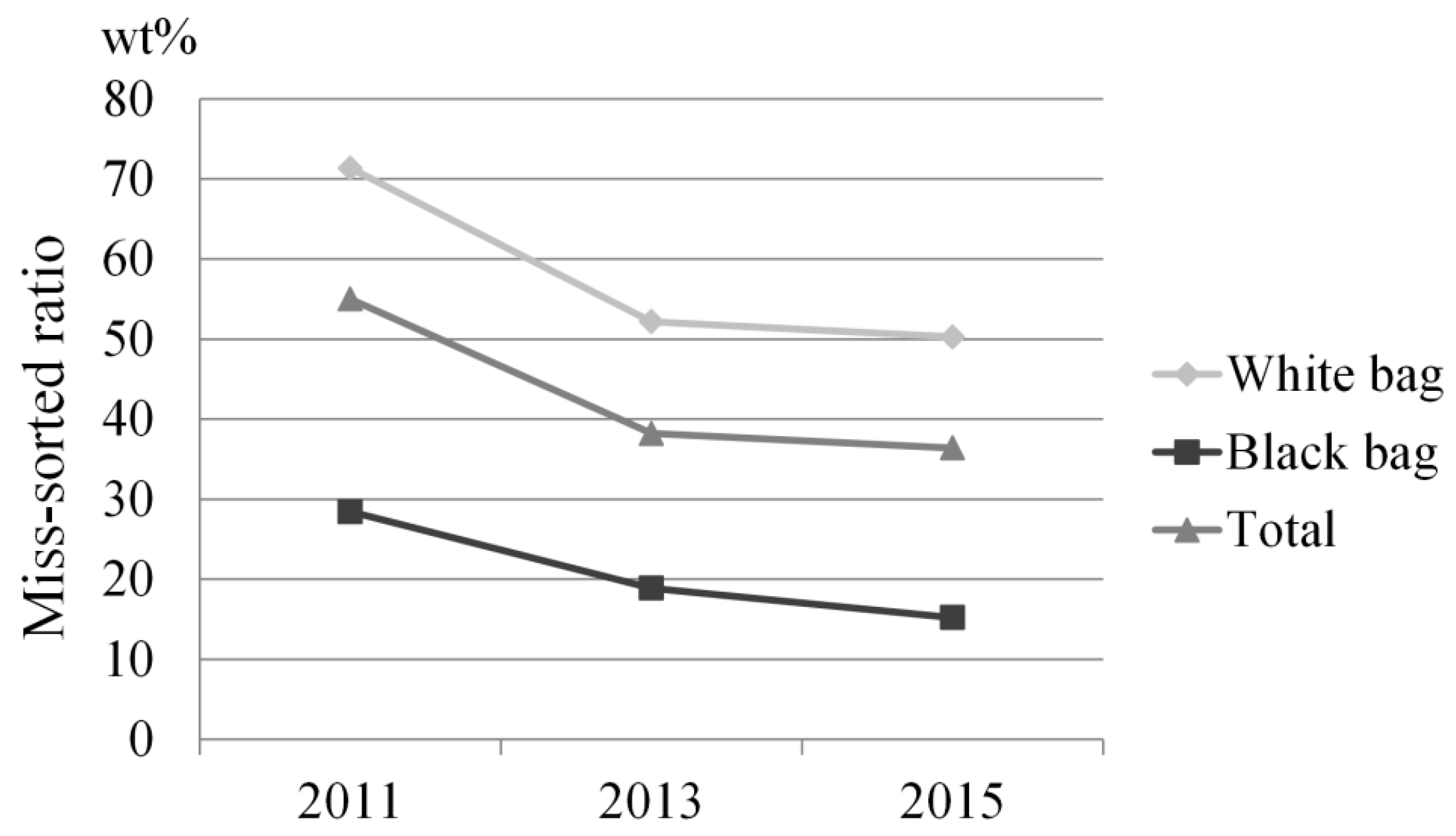
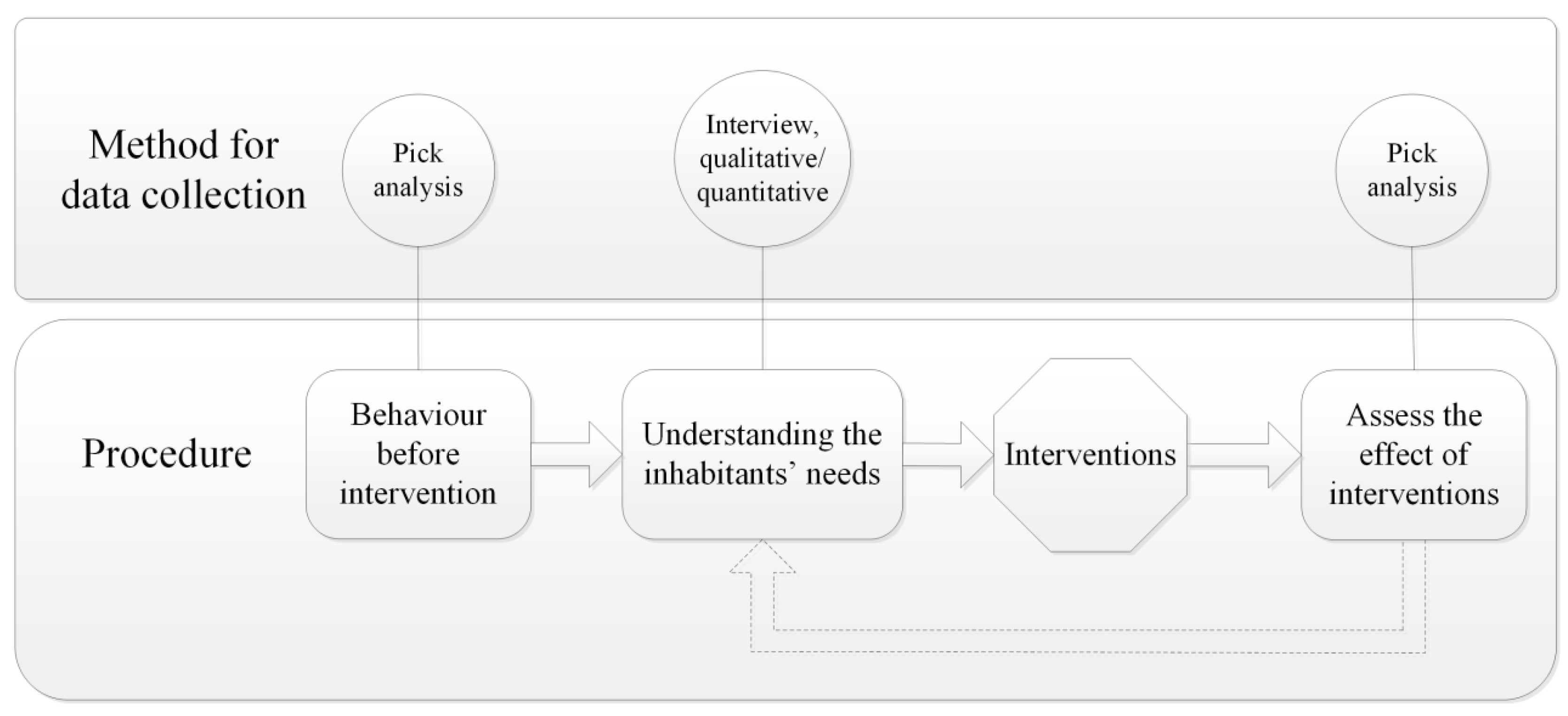
| Date | Unit of Sample | No. of Samples per Week | Total Samples | Total Weight (kg) |
|---|---|---|---|---|
| November 2011 | Waste in a 660 liter bin | 7 | 28 | 1732.9 |
| November 2013 | Waste in a 660 liter bin | 7 | 28 | 1699.0 |
| November 2015 | Waste in a 660 liter bin | 7 | 28 | 1592.5 |
| Category | Subcategory | Fractions | Sorting Instruction |
|---|---|---|---|
| Food | Food | Leftover food, fruits, vegetables, etc. | Black bag |
| Packaging, newsprints | Paper packaging | Cardboard, paper packaging | Recycling station |
| Plastic packaging | Plastic film packaging, foam plastic packaging, dense plastic packaging | ||
| Glass packaging | Colored and clear glass packaging | ||
| Metal packaging | Metal packaging | ||
| Newsprint | Newsprint, advertisements, paperbacks, writing/drawing papers | ||
| Deposit bottles 1 | PET 2, Aluminum cans and glass bottles with deposit | ||
| Combustible | Diapers | Diapers, pads | White bag |
| Textile fabrics | Clothes, shoes, different textiles | ||
| Combustible waste | Wood, small non-packaging plastic, garden waste, wood, non-packaging paper, cat sand, tissues, envelopes, Christmas cards, small baby tools, pens, cigarette butts, vacuum cleaner bags, etc. | ||
| Other | Non-packaging plastic | Big parts | Recycling center |
| Non-packaging metal | Any metal parts | ||
| Non-packaging glass | Broken glass | ||
| Other non-combustibles | Ceramics, broken mug, bricks, etc. | ||
| Hazardous | Medicines 3 | Recycling center | |
| Batteries | |||
| Small electronics | Mobile phones, clocks, battery chargers, etc. | ||
| Light-bulbs | |||
| Other hazardous | Glues, chemicals, full sprays |
| Person | Sex | Age | Arrival Date a | Years Lived in the City | Occupation | Family Members |
|---|---|---|---|---|---|---|
| 1 | F | 25 | 2007 | 2 | No | 1 |
| 2 | F | 39 | 1990 | 15 | Yes | 5 |
| 3 | F | 50 | 1992 | 18 | Part time | 1 |
| 4 | F | 38 | 1997 | 10 | Yes | 4 |
| 5 | F | 40 | 1985 | 7 | Yes | 1 |
| 6 | F | 45 | 1997 | 16 | Yes | 2 |
| 7 | M | 40 | 2006 | 5 | Part time | 1 |
| 8 | F | 76 | Born in Sweden | 57 | Retired | 1 |
| Date | Intervention |
|---|---|
| June 2012 | (a) Placing new stickers for black bags trash cans which clearly show that food waste should be sorted in the black bags. |
| June 2013 | (b) Building a property close collection area for recyclables, called an environmental room, behind the apartment building to decrease the distance to the recycling station to 50 meters. The environmental room enabled the sorting of packaging, batteries, small electronics, light bulbs, and clothes. |
| 2014–2015 | (c) Communicating different types of information including: Installation of a picture on the containers for white and black bags showing where and how to sort this waste in the containers (2014). Sending written information, feedback and a “thank-you letter” three times to all households in the pilot area (2014). Having informal dialogues about using the environmental room and on how to improve the sorting in black bags (2015). |
© 2016 by the authors; licensee MDPI, Basel, Switzerland. This article is an open access article distributed under the terms and conditions of the Creative Commons by Attribution (CC-BY) license (http://creativecommons.org/licenses/by/4.0/).
Share and Cite
Rousta, K.; Bolton, K.; Dahlén, L. A Procedure to Transform Recycling Behavior for Source Separation of Household Waste. Recycling 2016, 1, 147-165. https://doi.org/10.3390/recycling1010147
Rousta K, Bolton K, Dahlén L. A Procedure to Transform Recycling Behavior for Source Separation of Household Waste. Recycling. 2016; 1(1):147-165. https://doi.org/10.3390/recycling1010147
Chicago/Turabian StyleRousta, Kamran, Kim Bolton, and Lisa Dahlén. 2016. "A Procedure to Transform Recycling Behavior for Source Separation of Household Waste" Recycling 1, no. 1: 147-165. https://doi.org/10.3390/recycling1010147
APA StyleRousta, K., Bolton, K., & Dahlén, L. (2016). A Procedure to Transform Recycling Behavior for Source Separation of Household Waste. Recycling, 1(1), 147-165. https://doi.org/10.3390/recycling1010147







